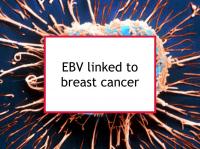Links between viral infection and cancer have been established for several viruses, among them hepatitis B and C (liver cancer), HPV (cervical cancer), human T lymphotrophic virus type 1 (HTLV-1) (T-cell leukemia), and Epstein-Barr (EBV) (various cancers). Now a new study has demonstrated that certain EBV gene sequences present in breast tumors are differentially expressed according to breast cancer subtype.
A majority of U.S. adults are infected by EBV, which establishes a persistent latent infection. EBV is a type of herpes virus best known for causing infectious mononucleosis (mono) in teenagers and young adults. It has also been linked to multiple sclerosis (MS). However, EBV is also associated with a variety of cancers, including lymphoid malignancies such as B and T cell lymphomas and Hodgkin’s lymphoma, and epithelial malignancies such as gastric cancer and nasopharyngeal cancer (and, possibly, breast cancer).
It can take years or even decades for infection with an oncogenic virus such as EBV to result in cancer, and only a minority of those infected will actually progress to cancer. This is because such viruses do not appear to cause cancer directly, but may induce a tissue microenvironment that is supportive of cancer initiation or growth. For the most part, an oncogenic viral infection can be thought of as a cancer risk factor rather than a trigger that inevitably causes cancer.
Although, at the moment, there is no EBV vaccine or other practical method for avoiding such infection, EBV status may become a useful prognostic factor for breast cancer. Infection with EBV has been shown to be associated with more aggressive breast cancer subtypes and appears to be associated with less favorable outcomes.
Latest research reports EBV link to aggressive BC
The study referenced above was designed to test the hypothesis that EBV plays a role in the etiology, heterogeneity, and pathogenesis of breast cancer and its subtypes. This meant identifying the varying expression of gene sequences involved and determining the predicted role of EBV gene sequences found in breast cancer subtypes (in comparison to those present in normal tissue used as control).
To conduct the study, the authors used existing deep sequencing RNA-seq datasets derived from 17 breast tumors and three normal breast tissue samples. Three-fold higher levels of EBV-expressed sequences were observed in the tumors compared to the normal breast tissue. The authors also found differential expression of EBV gene transcript sequences in 26 genes in the tumors compared to the normal breast tissue.
In addition, tumor-specific EBV gene transcript sequences localizing to nine genes were shown to be expressed differentially in a breast cancer subtype-specific manner. Finally, the authors report for the first time (using functional analysis of the differentially expressed integrated EBV transcript sequences) that these sequences have the capacity to generate novel EBV miRNAs. The authors conclude that these integrated EBV sequences "could potentially play a role in the pathogenesis of breast cancer and its most aggressive subtypes."
